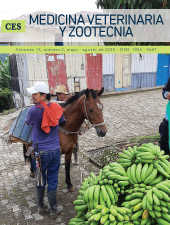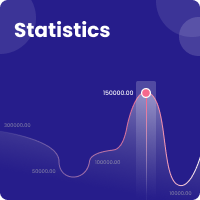Genetic relationship between insemination bulls marketed in Chile by two semen suppliers: a case study in Holstein and Angus breeds
DOI:
https://doi.org/10.21615/cesmvz.15.2.3Keywords:
artificial insemination, inbreeding, inbreeding depression, genealogical record, effective population sizeAbstract
Artificial insemination (AI) is currently the preferred reproductive management for most cattle farmers working with international cattle breeds likes Holstein Friesian and Aberdeen Angus. In relation to this, several authors have described that over the years there has been an alteration in the production parameters, which would be significantly associated with an increase in the inbreeding degree of the animals. This fact would have
its origin at the genetic nucleus level, in which improvement programs are
carried out, due to the small number of family lines which the animals selected as breeding stock belong to. This study evaluated the degree of kinship between Holstein Friesian and Aberdeen Angus insemination bulls marketed in Chile by two semen distribution companies. A total of 86
bulls available in catalogues until 2017 were studied. The genealogical information of each bull was traced back up to great-great-grandfather
and then a consolidated genealogical record was built for each breed. This analysis considered the estimation of each bull’s inbreeding percentage (F) and the construction of a co-ancestry matrix among animals. Results indicated that 99% of Holstein bulls and 79% of Angus bulls, are related to some extent. As a result of the above, it is concluded that is essential that in Chile a program management of genealogical information be initiated to adequately control inbreeding problems that may arise from the use of related animals.
Downloads
References
Álvarez P, Hernández JR, y Magaña F. Efecto de consanguinidad sobre la producción láctea en vacas Holstein en el establo La Estrella, León, Gto., México. Revista Chapingo Serie Zonas Áridas. 2010; 9: 71-75.
American Angus Association. [acceso junio y julio de 2018].URL: http://www.an-gus.org.
Angus Australia. [acceso junio y julio de 2018].URL: http://www.angusaustralia.com.au.
American Holstein Association. [acceso junio y julio de 2018].URL: http://www.holsteinusa.com.
Caraviello DK, Weigel KA, Gianola D. Analysis of the relationship between types traits and functional in US Holstein cattle using a Weibull proportional hazards model. J Dairy Sci 2004; 87: 2677-2686.
Bezdíček J, Louda F. Relationship between inbreeding and the major histocom-patibility complex: a review. Slovak J Anim Sci 2018; 51 (3): 119-127.
Casanova L, Hagger C, Kuenzi N, Schneeberger M. 1992. Inbreeding in Swiss Braunvieh and its influence on breeding values predicted from a repeatability animal model. J Dairy Sci 2018; 75: 1119-1126.
Cassell, B.G., V. Adamec and R.E. Pearson. Effect of incomplete pedigrees on es-timates of inbreeding and inbreeding depression for days to first service and summit milk yield in Holsteins and Jerseys. J. Dairy Sci. 2003a; 86: 2967-2976.
Cassell, B.G., V. Adamec and R.E. Pearson. Maternal and fetal inbreeding depression for 70-Day nonreturnand calving rate in Holsteins and Jerseys. J. Dairy Sci. 2003b; 86: 2977-2983.
De la fuente L. Curso de Reproducción e Inseminación artificial en ganado Ovino y Caprino. Ovigen. Departamento de Producción Animal Universidad de León. 2016. [acceso enero de 2019]. URL: https://www.oviespana.com/images/imagenes/empresas/assaf/assaf_cursos/assaf_curso_13-4-16/assaf_curso_13-4-16_2/inseminacion_mejora_genetica.pdf.
Dutra F. Monstruosidades y enfermedades genéticas de los bovinos en Uruguay. Su importancia y significado. XLIV Jornadas Uruguayas de Buiatría, Paysandú, Uruguay.
Falconer D, Mackay TF. Introducción a la genética cuantitativa. 1ra ed. España. Editorial Acribia; 2001.
Fernández M. Consanguinidad en bovinos, lo que necesita saber. Revista Angus 2005; 229: 120-122.
Florio J. Consanguinidad en la ganadería bovina. Manual de Ganadería doble propósito 2005; 10: 129-134.
Guest B. Consanguinidad en bovinos. Revista Angus Society Australia 2008; 241: 54-55.
Gutierrez JP, Goyache F. A note on ENDOG: a computer program for analyzing pedigree information. J Anim Breed Genet 2003; 122: 357-360.
Hermas SA, Young CW, Rust JW. Effects of milk inbreeding on productive and re-productive performance of Guernsey cattle. J Dairy Sci 1987; 70: 712-715.
Malécot G. La consanguinité dans une population limitée. C. R. Acad Sci Paris 1946; 222: 841-843.
Meuwissen TI, y Luo Z. Computing inbreeding coefficients in large populations, Genet Sel Evol 1992; 24: 305-313.
Miglior F, Szkotnicki B, Burnside EB. Analysis of levels of inbreeding and inbreeding depression in Jersey cattle. J Dairy Sci 1992; 75: 1112-1118.
Oficina de Estudios y Políticas Agrarias (ODEPA). Avance por producto – país de exportaciones / importaciones. [acceso septiembre de 2018]. URL: https://www.odepa.gob.cl/avance-por-producto-pais-de-importacion-y-exportacion.
Parland S, Kearney M, Rath JF, Berry M. Inbreeding effects on milk production, calving performance, fertility, and conformation in Irish Holstein Frisians. J Dairy Sci 2007; 90: 4411-4419.
Quaas RL. Computing the diagonal elements of a large numerator relationship matrix. Biometrics 1976; 32: 949-953.
Smith B. Medicina interna de grandes animales. Barcelona, España. GEA consul-toría editorial S.L; 2010.
Smith LA, Cassell BG, y Pearson RE. The effects of inbreeding on the lifetime performance of dairy cattle J. Dairy Sci. 1998; 81: 2729-2737.
Sumreddee P, Toghiani S, Hay EH, Roberts A. Agrrey SE, Rekaya R. Inbreeding depression in line 1 Hereford cattle population using pedigree and genomic in-formation. Journal of animal Science 2019; 97(1): 1-18.
Thompson J, Everett R, Wolfet C. Effects of inbreeding on production and survival in Jersey. J Dairy Sci2000a; 83: 2131 – 2138.
Thompson J, Everett R, Hammerschmidtt N. Effects of inbreeding on production and survival in Holsteins. J Dairy Sci 2000b; 83: 1856-1863.
Van Raden PM. Inbreeding Adjustments and Effect on Genetic Trend Estimates. Animal Improvement Programs Laboratory, Agriculture Research Service, Uni-ted States Department of Agriculture. Proceedings of the 2005 Interbull meeting 2005; 33: 81-84
Velarde JLV. Consanguinidad y su importancia en el mejoramiento genético de la alpaca. Sistema de Revisiones en Investigación. Sitio Argentino de Producción animal. 2011. [acceso agosto de 2019]. URL: http://www.produccion-animal.com.ar/produccion_de_camelidos/Alpacas/20-consanguinidad.pdf.
Weigel KA y Lin SW. Controlling inbreeding by constraining the average relationship between parents of young bulls entering AI progeny test programs J. Dairy Sci. 2002; 85: 2376-2383.
Wiggans GR, VanRaden PM, Zuurbier YJ. Calculation and use of inbreeding coeffi-cients for genetic evaluation of United States dairy cattle. J. Dairy Sci. 1995; 78: 1584–1590.
Wright S. Evolution in mendelian populations. Genetics 1931; 16 (2): 97-159.
Wilk JC y McDaniel BT. Effect of inbreeding on heifer survival to first calving in Jerseys. J. Dairy Sci. 1996; 79: (Abst): 205.
Downloads
Published
How to Cite
Issue
Section
License
Copyright (c) 2020 CES Medicina Veterinaria y Zootecnia

This work is licensed under a Creative Commons Attribution-ShareAlike 4.0 International License.
| Article metrics | |
|---|---|
| Abstract views | |
| Galley vies | |
| PDF Views | |
| HTML views | |
| Other views | |



